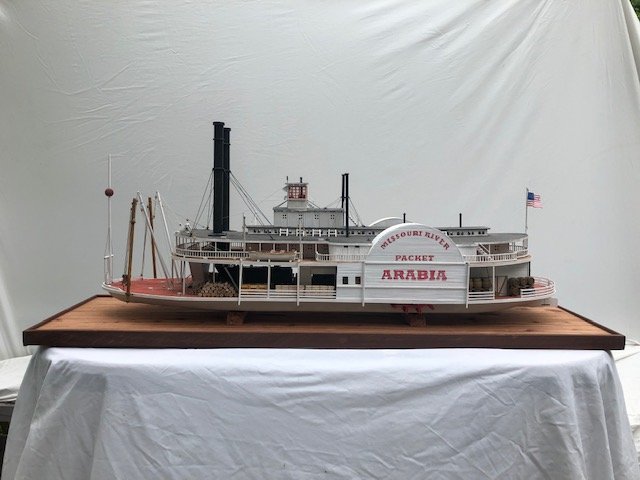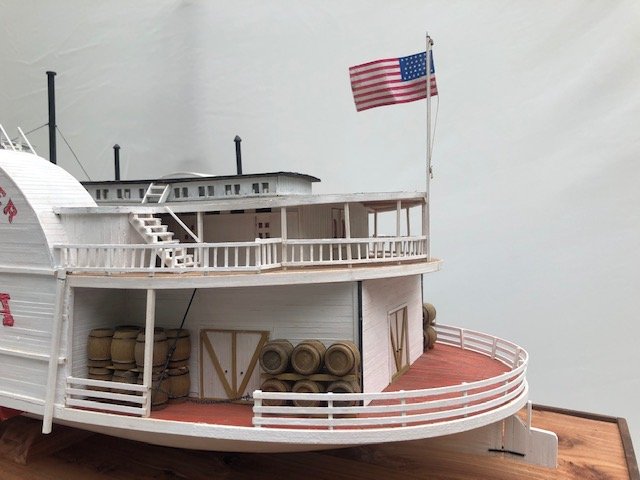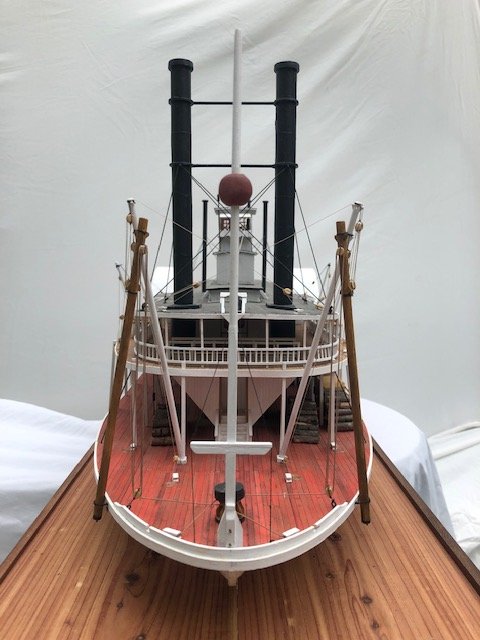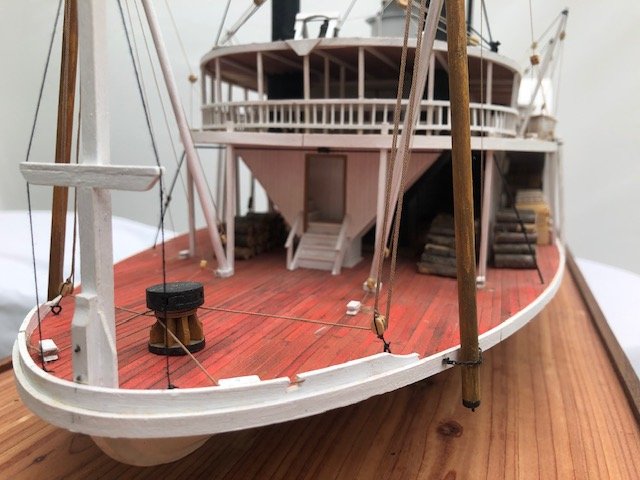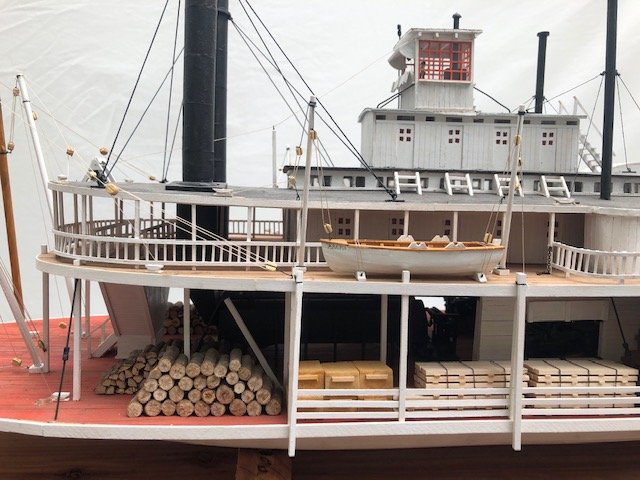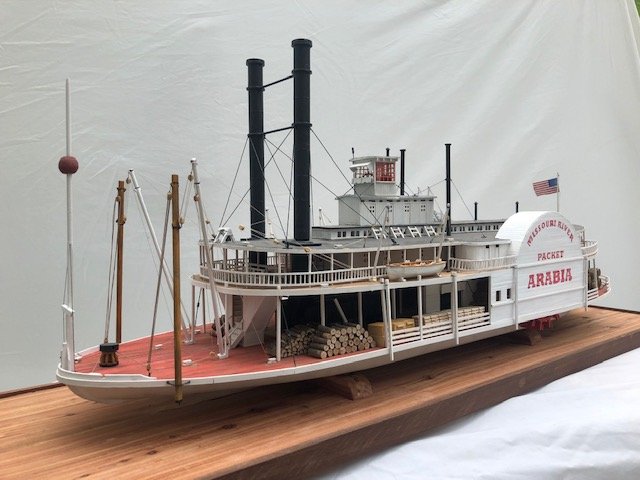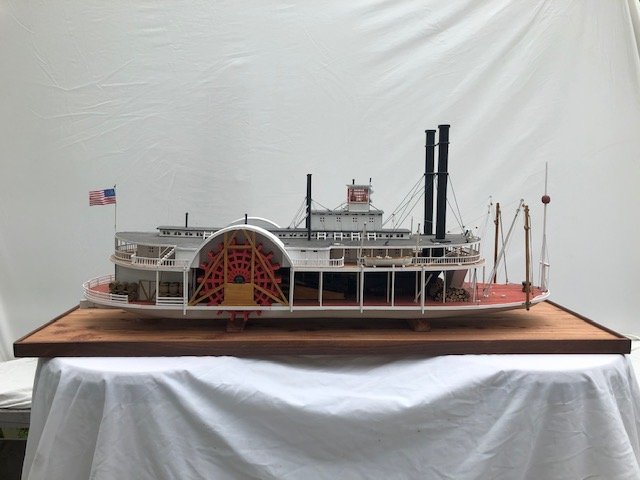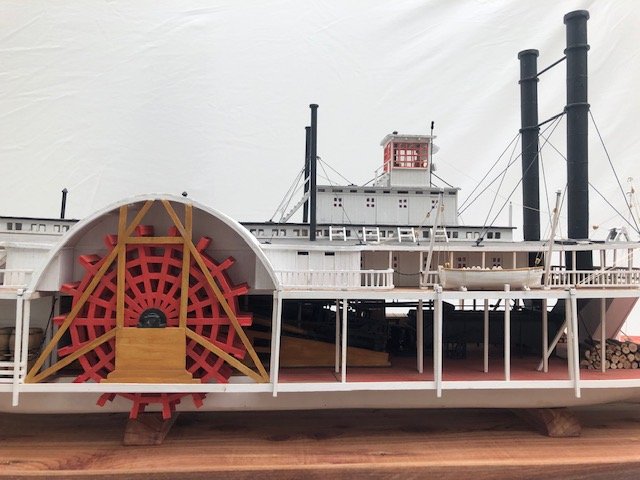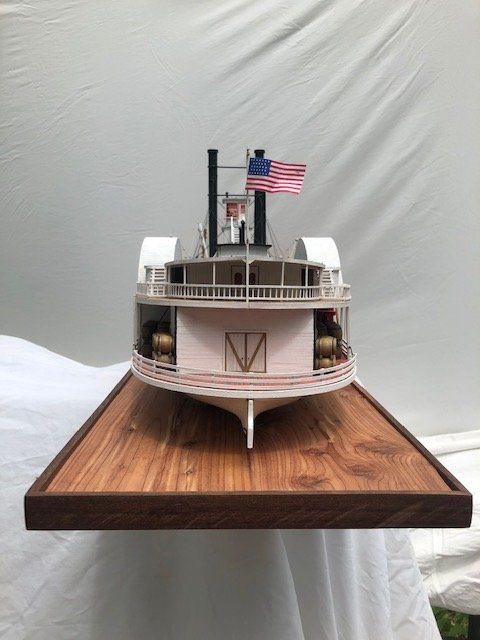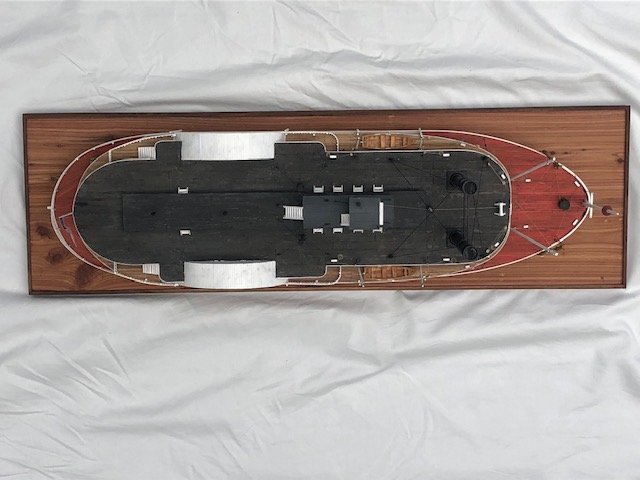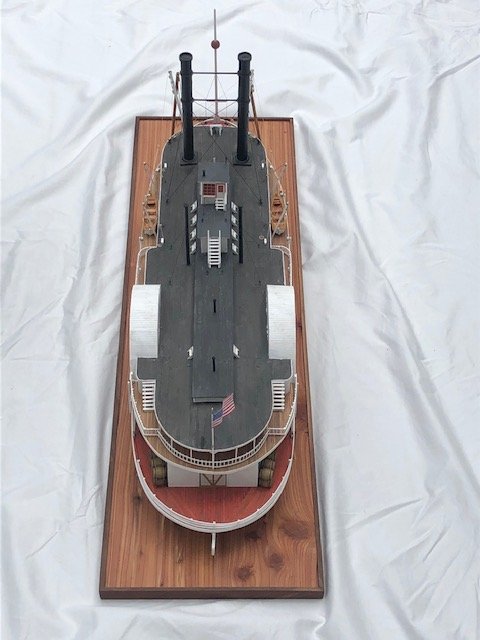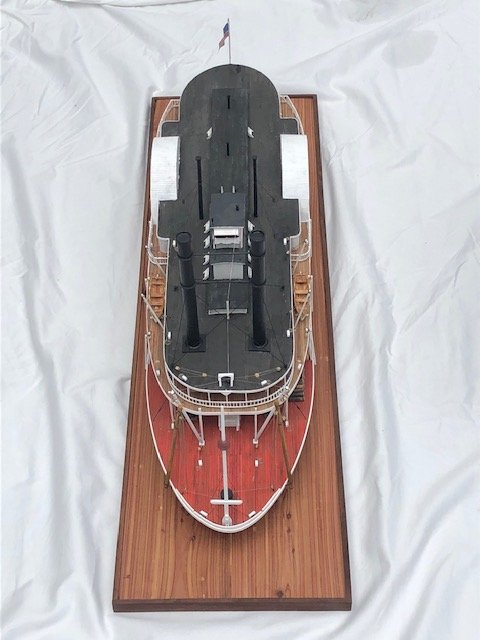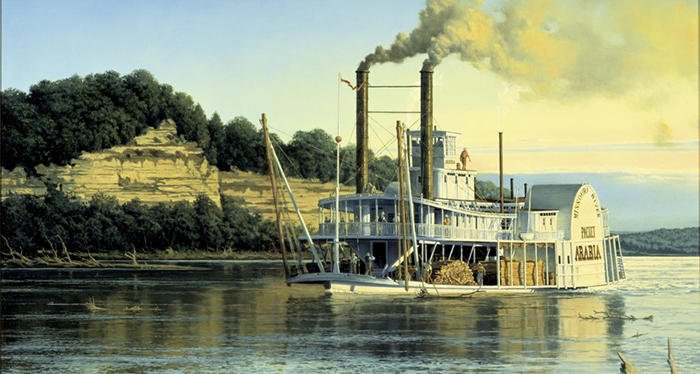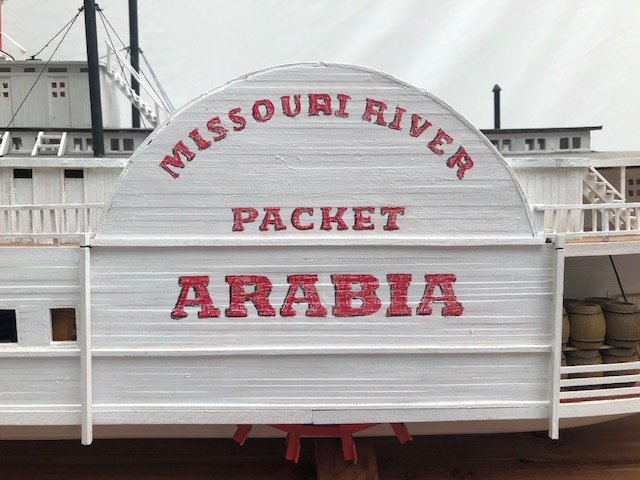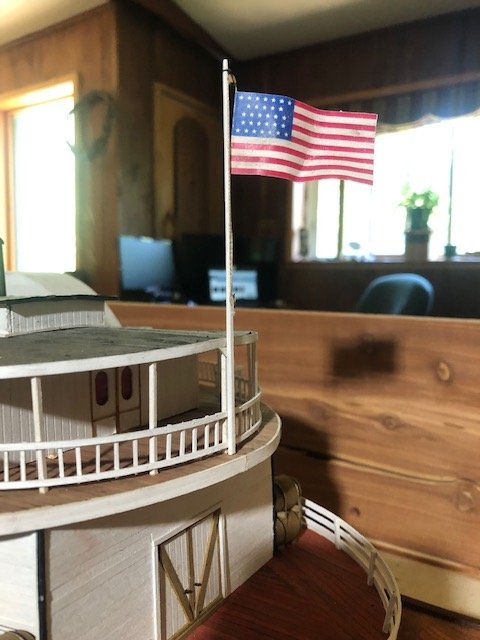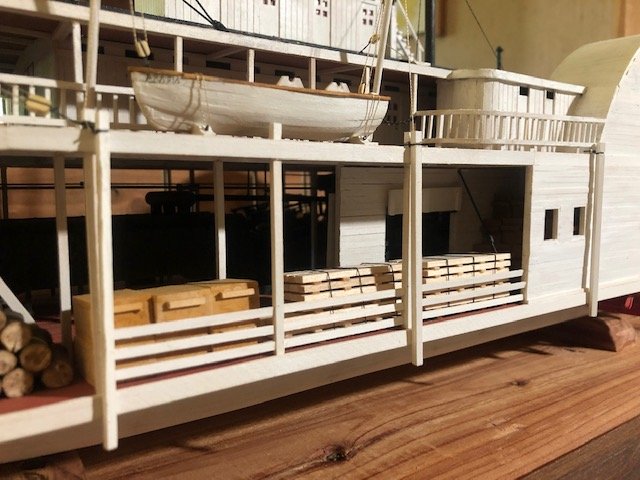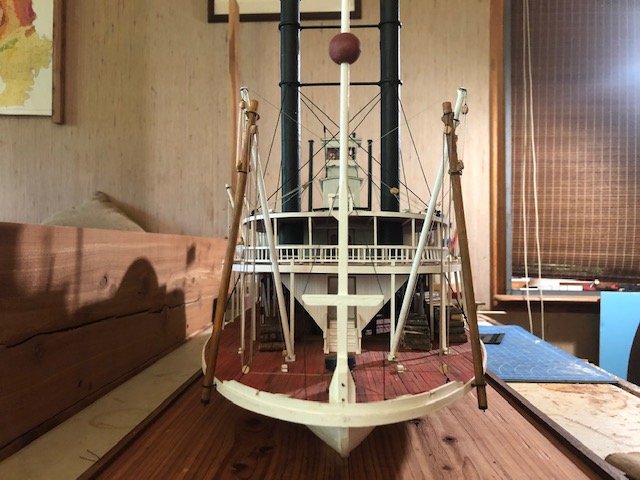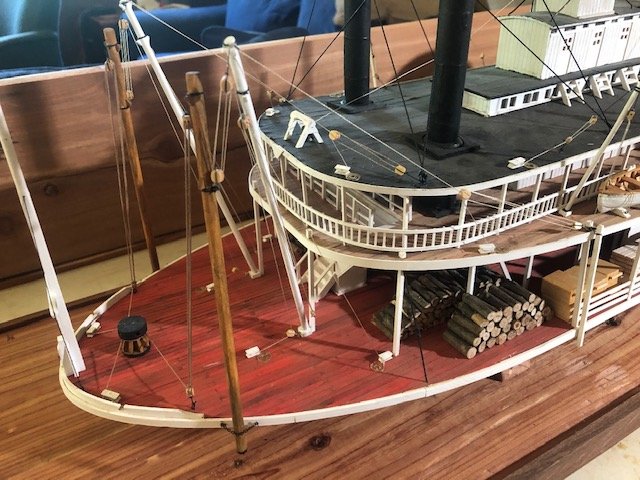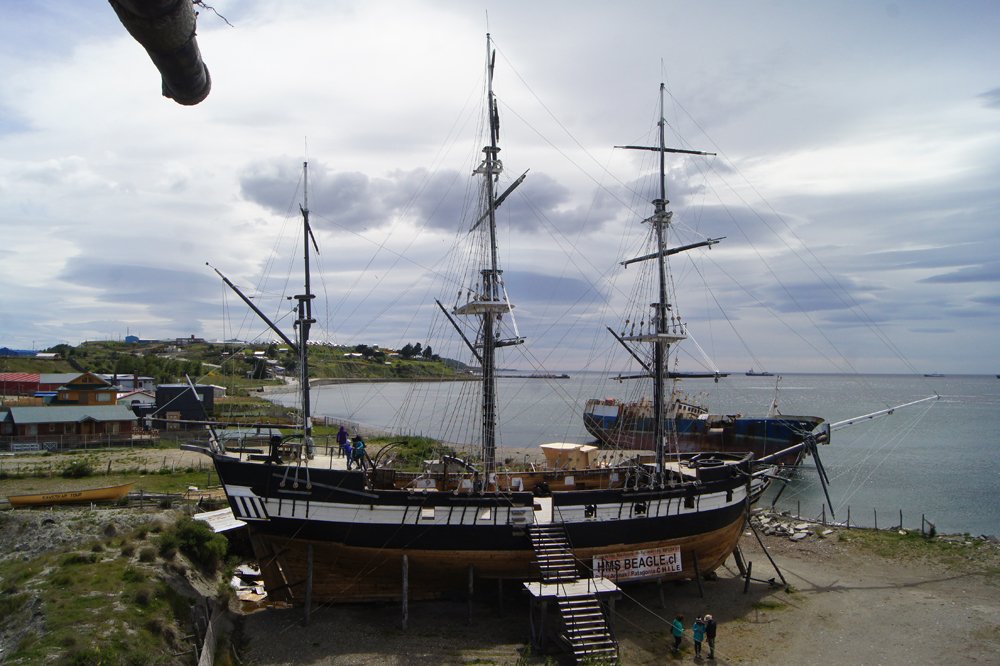-
Posts
3,522 -
Joined
-
Last visited
Content Type
Profiles
Forums
Gallery
Events
Everything posted by Cathead
-
Four mounting points make a lot of sense, I did the same thing with Arabia. These flat, wide bottoms are perfect for that and I feel a lot better with the foursquare support. Treenailing in the false keels is a good touch, too.
-
I took advantage of a cloudy afternoon to take a break from regular work and do a quick photo shoot on my porch, using my phone with a few rumpled sheets as backdrops. May try to do a nicer job someday but the model's not going anywhere and this let me feel a sense of closure. It was pretty windy and you'll see the flag changing positions! First, a few overhead shots: Stern views: Bow views: Side views: Overall views: Painting for comparison with the last view: Thanks for everything.
- 599 replies
-
- sidewheeler
- arabia
-
(and 4 more)
Tagged with:
-
I finally got an updated (larger) stencil from the neighbor teen and relettered the wheel housing. I like this much better: Compare with the earlier, too-small version: And with that, she's done. Next post will feature some final shots. Wow. I'm having a hard time adjusting to this, after 2 years and 8 months, the longest I've worked on any model project. I can't emphasize enough how important all of you have been, through likes, comments, suggestions, criticisms, and support. Even when I didn't take your advice, I listened to it and learned from it. You've helped me create something pretty special to me, and maybe to others if I ever get to display it somewhere other than my quarantined rural farmstead. Thank you.
- 599 replies
-
- sidewheeler
- arabia
-
(and 4 more)
Tagged with:
-
Model Expo is shipping and they sell packaged strips in all kinds of dimensions that are very useful.
-
That's what "fairing" refers to; bulkhead edges need to be filed to an angle that matches the flow of the planks. I thought that's what we had been talking about. Have you read any of the planking tutorials here on MSW? They'd be pretty helpful. If your bulkheads haven't accounted for this, there's a way to fix it. Many of us, when fairing, mistakenly take off too much at some point, resulting in the plank not sitting properly as you describe. You could use filler as you suggest, but it's often easier to glue a thin strip of wood to the outside edge of the bulkhead, then sand this back down to the properly faired angle.
-
Wait, so are you or aren't you burning it? It's your choice, just confused as to the plan.
-
I agree with Petr. If you want to have it just-so for your own satisfaction, that's fine, but it should have little bearing on whether it floats (that would seem to relate more to whatever sealant is used and proper ballasting, not precise planking). As for burning, I recall reklein sharing photos of a model he gave a proper flaming burial to (earlier in this thread), but I don't recall Kris saying that was the purpose of this model (just that it represented a personally symbolic "burial"). Did I miss something? I'm still not sure about the reasoning regarding needing to get the fairing right before gluing in the bulkheads.
-
Well done and thanks for sharing. A beautiful build.
- 66 replies
-
- Finished
- Model Shipways
-
(and 1 more)
Tagged with:
-
In terms of general fairing, I don't think you need a scale plank. Any strip of flexibile material is enough to test the accuracy of fairing, either wood thin enough to bend easily or plastic/styrne. The goal is to ensure that you always have a smooth run between bulkheads (i.e the plank/trip doesn't lift off the bulkhead or have a gap) and that shouldn't require a precise plank width. I'm not sure what you mean by this: Do you mean that you don't want to glue the bulkheads in place before fairing, i.e. that you're trying to fair them before installation? Normal procedure would be to glue the bulkheads in place, then fair them all in one go. Or am I misunderstanding you?
-

Hello from a New "Old" member from Coastal NC
Cathead replied to OldChur's topic in New member Introductions
Welcome. Coastal NC has been a special place in my family for over 40 years and I envy your proximity. I hope you'll find value and peace in returning to this community. -

To add sails or not? What is your preference?
Cathead replied to Bill97's topic in Masting, rigging and sails
I am no master modeller, but for my last sailing vessel I developed a sail-making method I quite liked and wrote it up here. Feel free to review it and the ensuing discussion for whatever knowledge and ideas you might want to glean. -
A real ship's hatches would likely be aligned to fit between the regular deck beams to eliminate the problem you describe.
-
Roger, thanks so much. That means a lot coming from you. You've been such a help and inspiration as I learn more about steamboats over the years and you've helped me hold myself to a higher standard (though I still have a ways to go). Brian, I was thinking (hoping?) that I could get an inexpensive plexiglass case made that would fit over the model and inside the raised lip around the wooden base. I was thinking of contacting a few sign-making shops that seem to do various such work. Anyone have a smarter idea?
- 599 replies
-
- sidewheeler
- arabia
-
(and 4 more)
Tagged with:
-
Keith, I do have my next project selected, but am keeping it under wraps for now until I can truly declare this one done. Some may be disappointed to learn that it is not another riverboat; after 2.5 years of this complex scratchbuild, and under the higher level of stress I'm currently under for various reasons, I needed something simpler that someone else wrote directions for. Will reveal once I'm ready. I think it'll be fun. In the meantime, anyone looking for a new riverboat scratchbuild should head on over to Brian's just-started USS Cairo, which promises to be fascinating. John, that sounds really cool and I'd love to follow along. When you get started, feel free to drop a note in here so we can all be in on it from the beginning.
- 599 replies
-
- sidewheeler
- arabia
-
(and 4 more)
Tagged with:
-
Port rigging is done: Bow view: I added a few final details. For example, there should be a series of posts hung from the sides to protect the vessel. These are similar in function to the tires commonly used by more modern tugs and other vessels. It was common on more busy waterfronts (like St. Louis) for steamboats to line up shoulder-to-shoulder, making these barriers necessary. Photos show a variety of setups, from posts integrated into the hull to those hung loosely from lines. I opted for the latter; you can see the lines tied off to structural posts if you look closely. A spot of glue at the lower end of each post holds it in place as these aren't dense enough to hang right on their own. For example, here's a view of the St. Louis levee in 1852 from the Steamboat Times website: For the final detail, I added a flagpole and flag to the sternmost part of the hurricane deck, rigging it using a small block. This is the 31-star flag used from 1851 to 1858, following the admission of California to the Union. As Arabia was built in 1853 and sank in 1856, the choice of flag was clear. I printed it on bond paper as a single front-and-back image that could be folded over itself with glue between. I did this with a line carefully inserted along the seam, then rubbed some grey pastel on to dull the paper. I think it has a good texture, and between the weight of the paper and the glue, it takes and holds a decent wavy bend. Notice MSW on the laptop in my home office, set in the opposite corner of our small living room from my workbench. Here's the contemporary drawing I based the flagpole on, from the UW steamboat photo database: Those are all the final details, save one: I want to redo the lettering on the wheelhouse. Something had been bugging me about it, and I finally realized that it came out smaller than I intended. I compared the 3D-printed stencil with my initial paper test print and found that the stencil was quite a bit smaller than it was supposed to be. Can't believe I didn't notice up front. Somehow the design shrank in the transfer from my graphics program to the file used for printing. So I contacted the neighbor's teen again and he's going to ensure that the final design is scaled properly before printing a new one. So once I get my hands on that, I'll paint over the original lettering and redo it. Then she'll be done. This might take until next week, so not sure when I'll do a final photo shoot. I want to do one here under the right outdoor lighting conditions (not too sunny) and I also want to take a walkaround video. My final goal is to take the model down to the Missouri River and do a photo shoot with her natural habitat in the background. Also not sure when I'll get to that; the best place to do this is at a conservation area about 45 minutes from me. Stay tuned just a little bit longer. Thanks for all your support, comments, and likes.
- 599 replies
-
- sidewheeler
- arabia
-
(and 4 more)
Tagged with:
-
Nemo, It's the Nao Victoria museum in Punta Arenas, Patagonia. I was going to link their site but it's down; see Wikipedia instead. See this post and the next few in my Chile thread for a series of photos; I can provide more if you're looking for details of a given area. Here's one photo for inspiration: You're right that it's not a good idea to post emails publically, but you can contact members privately through the site. Click on someone's name and go to their profile page. There's a fairly obvious "Message" button that lets you send private messages (usually called PMs around here) in which it's safe to exchange emails, etc. By the way, as my avatar suggests, I love your helper! EDIT: I'm not expert enough to judge the absolute accuracy. But the ship is littered with plans, and I got the impression they were shooting for a reasonably level of accuracy. Can't promise any detail is right. It's rather a Quixotic endeavor, mostly one guy's dream project.
-
Oh, wow, I've dreamed of building this ship! I grew up not far from where she sank and have a signed copy of the book about her (and the subsequent discovery efforts). I always thought I'd have to scratchbuild this, but now maybe not? Someday... Meanwhile, I strongly recommend the book (linked to by an earlier poster) as very well written and quite interesting for anyone interested in the design, construction, and operation of sailing vessels on the Great Lakes (some noticeable differences with marine conditions).
-
I've never built a double-planked hull, but general guidance suggests that wood glue is far superior to CA for holding wooden pieces. You've done a good job so far, your methods for plank bending are similar to my own. You're right to want to shape the planks first, and only glue them on when they're already formed and have minimal stress. Also, a few years ago I visited a museum in southern Chile which featured a full-scale replica of the Beagle. I took lots of photos, as this is on my model life list as a geologist, so would be happy to share if you'd find them interesting as references or simply inspiration. EDIT: Meant to add, there's a lot of planking tuturiols and other guidance in the dedicated section here on MSW: https://modelshipworld.com/forum/14-building-framing-planking-and-plating-a-ships-hull-and-deck/
-
Thanks, John. If there's interest, I'll do another diagram from the bow view once the port side is done.
- 599 replies
-
- sidewheeler
- arabia
-
(and 4 more)
Tagged with:
About us
Modelshipworld - Advancing Ship Modeling through Research
SSL Secured
Your security is important for us so this Website is SSL-Secured
NRG Mailing Address
Nautical Research Guild
237 South Lincoln Street
Westmont IL, 60559-1917
Model Ship World ® and the MSW logo are Registered Trademarks, and belong to the Nautical Research Guild (United States Patent and Trademark Office: No. 6,929,264 & No. 6,929,274, registered Dec. 20, 2022)
Helpful Links
About the NRG
If you enjoy building ship models that are historically accurate as well as beautiful, then The Nautical Research Guild (NRG) is just right for you.
The Guild is a non-profit educational organization whose mission is to “Advance Ship Modeling Through Research”. We provide support to our members in their efforts to raise the quality of their model ships.
The Nautical Research Guild has published our world-renowned quarterly magazine, The Nautical Research Journal, since 1955. The pages of the Journal are full of articles by accomplished ship modelers who show you how they create those exquisite details on their models, and by maritime historians who show you the correct details to build. The Journal is available in both print and digital editions. Go to the NRG web site (www.thenrg.org) to download a complimentary digital copy of the Journal. The NRG also publishes plan sets, books and compilations of back issues of the Journal and the former Ships in Scale and Model Ship Builder magazines.



